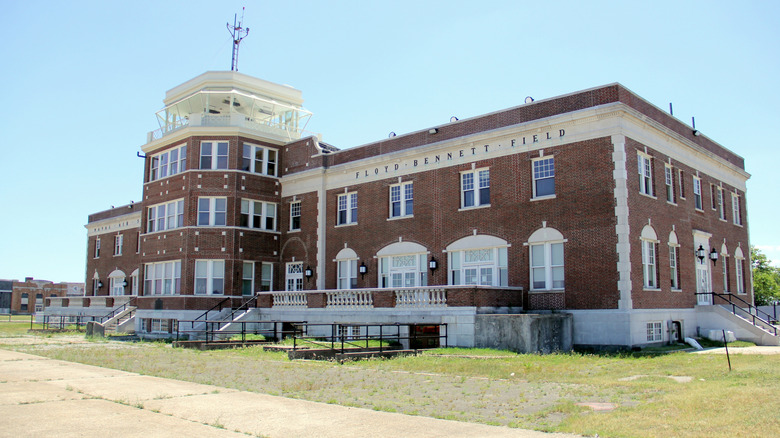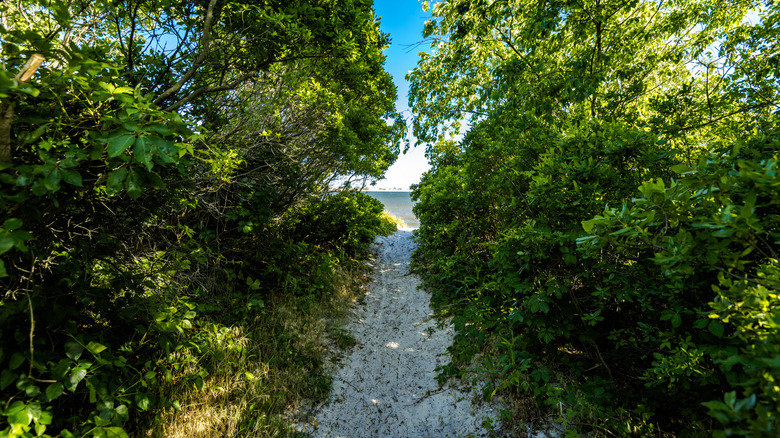This Historic National Recreation Area Used To Be A Popular New York Airport
Before New York City had John F. Kennedy International, it had LaGuardia. Before LaGuardia, there was — Floyd Bennett Field? If this name doesn't ring any bells, you're not alone: Only history buffs recall the Big Apple's first official airport, never mind the man it's named after. Commercial aircraft haven't landed here since the Great Depression, when it became a Naval Air Station, and even that was closed in 1971. Even fewer living people remember what this place looked like as an active airfield.
Yet paved runways still crisscross the 1,300-acre property, and it has retained the name Floyd Bennett Field. For decades, the grounds have served as a popular park on the southern coast of Brooklyn, where visitors can walk the grassy lawns, tramp through modest woods, and sun themselves on a small beach. Substantial artifacts from its days as an airport still stand at Floyd Bennett Field, giving the place an old-timey atmosphere, as if a biplane could suddenly emerge from the clouds and touch down on the gray airstrip.
This expansive green space has long been managed by the National Park Service, and it's free to visit any day of the week between 6AM and 9PM. The peripheral salt marshes and tidal mudflats are valuable habitats for local wildlife, and the on-site marina is popular with boaters and fishermen. But many visitors to New York are completely unaware Floyd Bennett Field exists, nor do they know its layered past. You could easily include this place on a list of underrated tourist attractions to add to your NYC itinerary.
The surprising history of Floyd Bennet Field
Commercial aviation was brand new in the 1920s, and even an important city like New York didn't have a proper airport until 1931. By the time it opened, though, the public was more than ready: About 25,000 people celebrated its ribbon-cutting, and within a couple years, Floyd Bennett was the setting for more than 50,000 flights. Founders commissioned a beautiful Deco-style control tower built out of brick, which still stands. Today, this administrative building is known as the Ryan Visitor Center, and houses exhibits about the early air field and its impact; visit any Saturday or Sunday.
As for the name, Floyd Bennett was a Navy pilot in the early 20th century, and he was born in Warrensburg in Upstate New York. The first aviator to fly over the North Pole was Lieutenant Commander Richard E. Byrd, whose name is forever tied to the daring aerobatic expedition; yet Bennett was his co-pilot, and both men were honored for their feat. Bennett was only 38 when he died of pneumonia in 1928, and the airport was posthumously dedicated to him three years later. Many ambitious flights were started here throughout the 1930s, including journeys across the Atlantic or around the world, and numerous pilots broke records.
The field had one major flaw: It was far from New York — about 25 miles from Times Square — and that distance felt a lot longer in a 1930s automobile. Even today, there's no easy way to reach Floyd Bennett Field, which is almost shocking in a city renowned for its subway system. The field was taken over by the US Navy during World War II, where personnel were trained and aircraft were tested. Today, the most luxurious airport in the US is John F. Kennedy Airport, one of New York's bustling travel hubs.
The quiet pleasures of Floyd Bennett Field
New York is home to many famous parks, from Central Park to Battery to Governors Island, where you can spend the night with this unique glamping experience. Compared to these more famous locations, Floyd Bennett Field is fairly understated.
But if you're venturing out to this part of Brooklyn, you'll find a landscape seemingly frozen in time; the vintage buildings are well-preserved, and you can walk, bicycle, or skateboard across the old runways. This is a rare chance to stand in the middle of that tarmac, where Grumman fighter planes once lifted off.
Regular visitors can take advantage of the archery range ($75 permit required), kayak launch (free), and Moonbeam Marina, which has 500 slips for larger boats. Lots of saltwater anglers come here to cast reels on the Sandy Fishing Beach, and Floyd Bennett Park Beach stands right next door; this is a pretty modest strip of sand, and few people would think to swim here, but it's a nice area to walk around, gaze at Jamaica Bay, and search the sky for a plane in flight.


